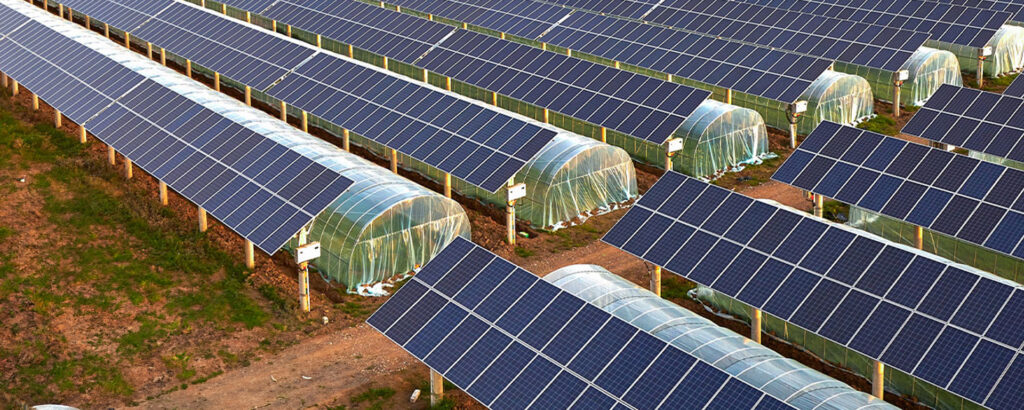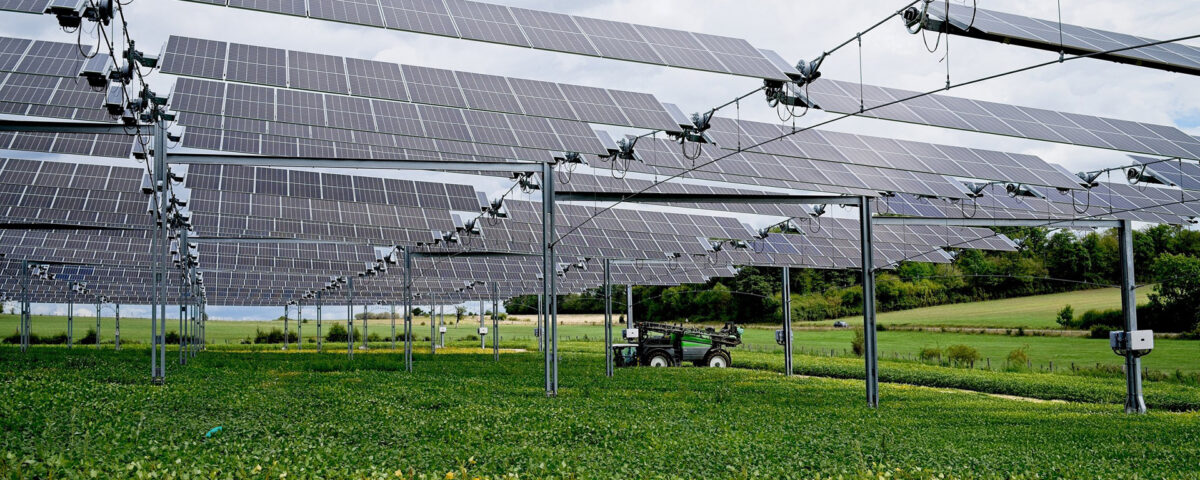Agrivoltaics
Joseph Martinez
on
November 29, 2024
The Future of Sustainable Farming with Advanced Renewable Concepts
Farms have always been at the heart of our communities, providing food, jobs, and a connection to the land. But today’s farmers face mounting challenges: rising energy costs, climate pressures, and the need to make every acre of land more productive. At Advanced Renewable Concepts (ARC), we believe in solutions that don’t just address these challenges but turn them into opportunities. That’s where agrivoltaics comes into play – revolutionizing the way farms produce energy and crops side by side.
What exactly is Agrivoltaics?
Agrivoltaics is the innovative practice of combining solar panels with farmland, allowing farms to produce energy and grow crops—or even raise animals—on the same land. It’s a system designed to enhance, not disrupt, daily agricultural operations. Solar panels are placed high enough to allow tractors to pass, crops to grow, or livestock to roam freely beneath them.
Take a horse pasture, for example. Panels installed in these spaces don’t just generate electricity—they also provide shade for animals, offering relief on hot days without interfering with grazing or movement. In orchards, panels can protect trees from intense sunlight while still allowing enough light for healthy growth. Agrivoltaics blends seamlessly into the daily rhythm of a farm, adding value without forcing compromises.
On the energy side, it’s just as efficient. Solar panels capture sunlight, converting it into electricity that can power farm operations or feed back into the grid for credits or income. The grid serves as a backup, ensuring farmers always have access to power, even when the sun isn’t shining.
With agrivoltaics, farmers don’t have to choose between energy production and their way of life. They get the benefits of clean, renewable energy without disrupting the traditions and routines that make their farms unique. It’s a win for productivity, sustainability, and peace of mind.
The benefits of Agrivoltaics for Farmers
1. Lower Energy Costs, Higher Savings
Farms often rely heavily on electricity for irrigation, cooling, storage, and machinery. By generating energy on-site with solar panels, farms can dramatically reduce their energy bills. Imagine cutting energy costs by up to 70% annually while protecting yourself from rising utility rates.
2. Dual Use of Land
Agrivoltaics allows you to make the most of every acre. Solar panels provide partial shade, creating a microclimate that can reduce heat stress on crops and livestock while improving soil moisture retention. Research shows that certain crops, such as leafy greens, thrive under these conditions, leading to healthier yields.
3. Diversified Income Streams
Solar energy isn’t just about savings—it’s about generating revenue. Farms can sell excess energy back to the grid or participate in Renewable Energy Credit (REC) programs to create an additional income stream. With programs like Illinois Shines, these credits can be sold for significant financial returns.
4. The Adoption of Sustainability
Adopting solar energy isn’t just about cutting costs—it’s an opportunity for farms to showcase their commitment to sustainability and leverage it for greater success. By integrating solar into their operations, farms position themselves as forward-thinking and environmentally responsible, which can strengthen their reputation and build trust within their communities.
This commitment to sustainability also opens doors to new markets. Many buyers, especially those seeking organic or premium products, are willing to pay more for goods produced responsibly. Solar adoption can set a farm apart, attracting contracts with retailers and distributors that value sustainability.
5. Federal and State Solar Energy Incentives
One of the most compelling reasons to invest in agrivoltaics is the availability of financial incentives that make it affordable and profitable.
Financial Incentives That Make Agrivoltaics Affordable
ARC specializes in helping farmers navigate the financial landscape of grants and tax incentives to maximize their investment. Here are some key programs that make agrivoltaic systems both affordable and profitable:
USDA REAP Grants:
The Rural Energy for America Program (REAP) offers grants that cover up to 50% of project costs for renewable energy systems. This significantly reduces the upfront expense, making solar installations more accessible.Federal Investment Tax Credit (ITC):
The ITC provides a 30% tax credit for solar installations, further lowering costs and ensuring a faster return on investment.MACRS Depreciation:
The Modified Accelerated Cost Recovery System (MACRS) allows farms to depreciate solar installation costs over just five years, offering substantial tax savings.Illinois Shines and REC Programs:
Programs like Illinois Shines enable farmers to sell Renewable Energy Credits (RECs) for additional income, further boosting financial returns.
With these combined incentives, many agrivoltaic systems can pay for themselves in as little as three years, allowing farms to begin reaping pure savings and additional revenue shortly thereafter. Agrivoltaics isn’t just a smart investment – it’s a fast and impactful one.
Why Choose ARC for Agrivoltaics?
At ARC, we understand that your farm is more than a business – it’s your livelihood and a way of life. That’s why we bring the same level of care and accountability to our agrivoltaic projects as you do to your fields. As a full-service EPC (Engineering, Procurement, and Construction) company, we handle every aspect of your solar installation in-house. From design and engineering to installation, our highly skilled team ensures every detail is done right.
Unlike other companies that rely on subcontractors, our crews are entirely internal. This means we maintain full control over quality and accountability, so you can trust that your farm’s needs are in the hands of professionals who take pride in their work. With consumer protections, high ratings, and a track record of delivering tailored solar solutions, we’re committed to helping farmers embrace renewable energy with confidence.
At ARC, we don’t just install solar systems – we partner with farmers to ensure sustainability and profitability for years to come.

Agrivoltaics System in Action
Imagine a 200-acre farm in Illinois. The farmer grows corn and soybeans and relies heavily on electricity for irrigation, grain drying, and other essential operations. With energy bills totaling $25,000 annually, rising utility costs are cutting into profits and making it harder to plan for the future. The farmer wants to reduce these expenses, build resilience, and make the farm more sustainable for the next generation.
After learning about agrivoltaics, the farmer decides to install a solar system on a portion of the property. By taking advantage of the USDA’s REAP grant, which covers up to 50% of project costs, and the Federal Investment Tax Credit (ITC), which provides a 30% tax credit, the financial barriers shrink significantly.
The system, which would typically cost $200,000 to install, is reduced by 50% through the REAP grant, leaving $100,000. The ITC further reduces this amount by 30%, bringing the farmer’s out-of-pocket cost to just $70,000. Recognizing the long-term savings potential, the farmer decides to aggressively pay off the system within three years using the energy cost savings.
The solar system installed is a 100-kilowatt system designed to offset 100% of the farm’s energy usage, meaning it generates enough electricity to completely eliminate the $25,000 annual utility bill. Over the next three years, the farmer uses these savings to recoup the $70,000 investment.
Energy Production Breakdown
A 100-kilowatt system in Illinois generates approximately 135,000 kilowatt-hours (kWh) annually, enough to power all of the farm’s equipment and operations. With utility rates averaging $0.18 per kWh, the system saves the farmer $25,000 each year.
After three years of payback, the system begins producing energy at no cost to the farmer. Over the system’s 25-year lifespan, the farmer saves $625,000 in avoided energy costs—all from an initial investment of just $70,000.
Additional Benefits
The system not only offsets energy costs but also creates opportunities for diversified revenue. Through Illinois Shines, the farmer sells Renewable Energy Credits (RECs), generating additional income that further enhances the profitability of the system. On top of this, the panels create shade for livestock, reducing heat stress, and improve soil moisture retention in the fields beneath, contributing to healthier crops and animals.
Agrivoltaics allows this farmer to turn a rising cost into a long-term asset. By integrating solar energy into daily operations, the farm becomes more resilient, more sustainable, and more profitable. With the right planning and incentives, this kind of transformation is within reach for farms of all sizes.
Savings Start As Soon As You Do.
Every day spent paying high energy bills is a missed opportunity to invest in your farm’s future. In Illinois, with rising utility costs and programs like USDA REAP grants and Illinois Shines available now, there’s no better time to take action. Waiting only means more dollars lost to energy companies and fewer opportunities to secure the incentives that are making solar affordable.
By simply starting the conversation, we can help you get informed and explore your options. While we’d love to handle your solar installation, our primary goal is to help you save money and make the most of what’s available. At ARC, we’re trailblazers in this industry, driven by a vision to build a better tomorrow for farmers and their communities.
If you’re just interested in learning more, we’re here to help. Contact us today, and let’s start planning for your farm’s brighter, more sustainable future.

